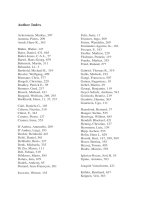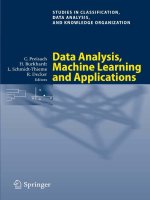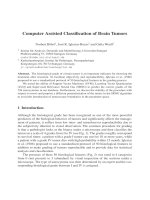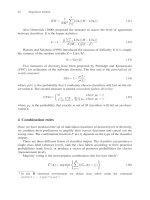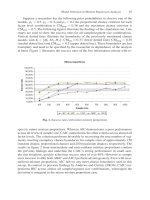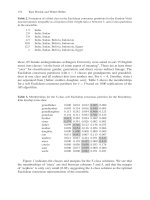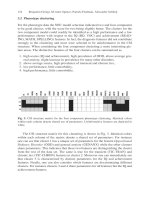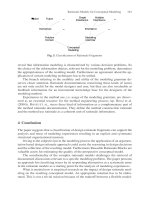Introducing data science big data, machine learning and more, using python tools (2016)
Bạn đang xem bản rút gọn của tài liệu. Xem và tải ngay bản đầy đủ của tài liệu tại đây (14.65 MB, 322 trang )
Big data, machine learning, and more, using Python tools
Davy Cielen
Arno D. B. Meysman
Mohamed Ali
MANNING
w.ebok30cm
Introducing Data Science
Introducing
Data Science
BIG DATA, MACHINE LEARNING,
AND MORE, USING PYTHON TOOLS
DAVY CIELEN
ARNO D. B. MEYSMAN
MOHAMED ALI
MANNING
SHELTER ISLAND
For online information and ordering of this and other Manning books, please visit
www.manning.com. The publisher offers discounts on this book when ordered in quantity.
For more information, please contact
Special Sales Department
Manning Publications Co.
20 Baldwin Road
PO Box 761
Shelter Island, NY 11964
Email:
©2016 by Manning Publications Co. All rights reserved.
No part of this publication may be reproduced, stored in a retrieval system, or transmitted, in
any form or by means electronic, mechanical, photocopying, or otherwise, without prior written
permission of the publisher.
Many of the designations used by manufacturers and sellers to distinguish their products are
claimed as trademarks. Where those designations appear in the book, and Manning
Publications was aware of a trademark claim, the designations have been printed in initial caps
or all caps.
Recognizing the importance of preserving what has been written, it is Manning’s policy to have
the books we publish printed on acid-free paper, and we exert our best efforts to that end.
Recognizing also our responsibility to conserve the resources of our planet, Manning books
are printed on paper that is at least 15 percent recycled and processed without the use of
elemental chlorine.
Manning Publications Co.
20 Baldwin Road
PO Box 761
Shelter Island, NY 11964
Development editor:
Technical development editors:
Copyeditor:
Proofreader:
Technical proofreader:
Typesetter:
Cover designer:
ISBN: 9781633430037
Printed in the United States of America
1 2 3 4 5 6 7 8 9 10 – EBM – 21 20 19 18 17 16
Dan Maharry
Michael Roberts, Jonathan Thoms
Katie Petito
Alyson Brener
Ravishankar Rajagopalan
Dennis Dalinnik
Marija Tudor
brief contents
1
■
Data science in a big data world
2
■
The data science process 22
3
■
Machine learning 57
4
■
Handling large data on a single computer 85
5
■
First steps in big data 119
6
■
Join the NoSQL movement
7
■
The rise of graph databases 190
8
■
Text mining and text analytics 218
9
■
Data visualization to the end user
v
1
150
253
contents
preface xiii
acknowledgments xiv
about this book xvi
about the authors xviii
about the cover illustration xx
1
Data science in a big data world 1
1.1
1.2
Benefits and uses of data science and big data 2
Facets of data 4
Structured data 4 Unstructured data 5
Natural language 5 Machine-generated data 6
Graph-based or network data 7 Audio, image, and video 8
Streaming data 8
■
■
■
1.3
The data science process 8
Setting the research goal 8 Retrieving data 9
Data preparation 9 Data exploration 9
Data modeling or model building 9 Presentation
and automation 9
■
■
■
1.4
The big data ecosystem and data science 10
Distributed file systems 10 Distributed programming
framework 12 Data integration framework 12
■
■
vii
CONTENTS
viii
Machine learning frameworks 12 NoSQL databases
Scheduling tools 14 Benchmarking tools 14
System deployment 14 Service programming 14
Security 14
■
13
■
■
1.5
1.6
2
An introductory working example of Hadoop 15
Summary 20
The data science process 22
2.1
Overview of the data science process 22
Don’t be a slave to the process 25
2.2
Step 1: Defining research goals and creating
a project charter 25
Spend time understanding the goals and context of your research
Create a project charter 26
2.3
26
Step 2: Retrieving data 27
Start with data stored within the company 28 Don’t be afraid
to shop around 28 Do data quality checks now to prevent
problems later 29
■
■
2.4
Step 3: Cleansing, integrating, and transforming data 29
Cleansing data 30 Correct errors as early as possible
Combining data from different data sources 37
Transforming data 40
■
2.5
2.6
Step 4: Exploratory data analysis 43
Step 5: Build the models 48
Model and variable selection 48 Model execution
Model diagnostics and model comparison 54
■
2.7
2.8
3
36
49
Step 6: Presenting findings and building applications on
top of them 55
Summary 56
Machine learning 57
3.1
What is machine learning and why should you care
about it? 58
Applications for machine learning in data science 58
Where machine learning is used in the data science process
Python tools used in machine learning 60
59
CONTENTS
3.2
ix
The modeling process 62
Engineering features and selecting a model 62 Training
your model 64 Validating a model 64 Predicting
new observations 65
■
■
3.3
Types of machine learning
Supervised learning
3.4
3.5
4
■
66
■
Semi-supervised learning
Summary 83
65
Unsupervised learning 72
82
Handling large data on a single computer 85
4.1
4.2
The problems you face when handling large data 86
General techniques for handling large volumes of data 87
Choosing the right algorithm 88 Choosing the right data
structure 96 Selecting the right tools 99
■
■
4.3
General programming tips for dealing with
large data sets 101
Don’t reinvent the wheel 101 Get the most out of your
hardware 102 Reduce your computing needs 102
■
■
4.4
Case study 1: Predicting malicious URLs 103
Step 1: Defining the research goal 104 Step 2: Acquiring
the URL data 104 Step 4: Data exploration 105
Step 5: Model building 106
■
■
4.5
Case study 2: Building a recommender system inside
a database 108
Tools and techniques needed 108 Step 1: Research
question 111 Step 3: Data preparation 111
Step 5: Model building 115 Step 6: Presentation
and automation 116
■
■
■
4.6
5
Summary 118
First steps in big data 119
5.1
Distributing data storage and processing with
frameworks 120
Hadoop: a framework for storing and processing large data sets
Spark: replacing MapReduce for better performance 123
121
CONTENTS
x
5.2
Case study: Assessing risk when loaning money 125
Step 1: The research goal 126
Step 3: Data preparation 131
Step 6: Report building 135
5.3
6
■
■
Step 2: Data retrieval 127
Step 4: Data exploration &
Summary 149
Join the NoSQL movement 150
6.1
Introduction to NoSQL 153
ACID: the core principle of relational databases 153
CAP Theorem: the problem with DBs on many nodes 154
The BASE principles of NoSQL databases 156
NoSQL database types 158
6.2
Case study: What disease is that?
164
Step 1: Setting the research goal 166 Steps 2 and 3: Data
retrieval and preparation 167 Step 4: Data exploration 175
Step 3 revisited: Data preparation for disease profiling 183
Step 4 revisited: Data exploration for disease profiling 187
Step 6: Presentation and automation 188
■
■
6.3
7
Summary 189
The rise of graph databases 190
7.1
Introducing connected data and graph databases 191
Why and when should I use a graph database?
7.2
193
Introducing Neo4j: a graph database 196
Cypher: a graph query language 198
7.3
Connected data example: a recipe recommendation
engine 204
Step 1: Setting the research goal 205 Step 2: Data retrieval 206
Step 3: Data preparation 207 Step 4: Data exploration 210
Step 5: Data modeling 212 Step 6: Presentation 216
■
■
■
7.4
8
Summary 216
Text mining and text analytics 218
8.1
8.2
Text mining in the real world 220
Text mining techniques 225
Bag of words 225 Stemming and lemmatization
Decision tree classifier 228
■
227
CONTENTS
8.3
xi
Case study: Classifying Reddit posts 230
Meet the Natural Language Toolkit 231 Data science process
overview and step 1: The research goal 233 Step 2: Data
retrieval 234 Step 3: Data preparation 237 Step 4:
Data exploration 240 Step 3 revisited: Data preparation
adapted 242 Step 5: Data analysis 246 Step 6:
Presentation and automation 250
■
■
■
■
■
■
8.4
9
■
Summary 252
Data visualization to the end user 253
9.1
9.2
Data visualization options 254
Crossfilter, the JavaScript MapReduce library 257
Setting up everything 258
medicine data set 262
9.3
9.4
9.5
appendix A
appendix B
appendix C
appendix D
■
Unleashing Crossfilter to filter the
Creating an interactive dashboard with dc.js 267
Dashboard development tools 272
Summary 273
Setting up Elasticsearch 275
Setting up Neo4j 281
Installing MySQL server 284
Setting up Anaconda with a virtual environment
index
291
288
preface
It’s in all of us. Data science is what makes us humans what we are today. No, not the
computer-driven data science this book will introduce you to, but the ability of our
brains to see connections, draw conclusions from facts, and learn from our past experiences. More so than any other species on the planet, we depend on our brains for
survival; we went all-in on these features to earn our place in nature. That strategy has
worked out for us so far, and we’re unlikely to change it in the near future.
But our brains can only take us so far when it comes to raw computing. Our biology can’t keep up with the amounts of data we can capture now and with the extent of
our curiosity. So we turn to machines to do part of the work for us: to recognize patterns, create connections, and supply us with answers to our numerous questions.
The quest for knowledge is in our genes. Relying on computers to do part of the
job for us is not—but it is our destiny.
xiii
acknowledgments
A big thank you to all the people of Manning involved in the process of making this
book for guiding us all the way through.
Our thanks also go to Ravishankar Rajagopalan for giving the manuscript a full
technical proofread, and to Jonathan Thoms and Michael Roberts for their expert
comments. There were many other reviewers who provided invaluable feedback
throughout the process: Alvin Raj, Arthur Zubarev, Bill Martschenko, Craig Smith,
Filip Pravica, Hamideh Iraj, Heather Campbell, Hector Cuesta, Ian Stirk, Jeff Smith,
Joel Kotarski, Jonathan Sharley, Jörn Dinkla, Marius Butuc, Matt R. Cole, Matthew
Heck, Meredith Godar, Rob Agle, Scott Chaussee, and Steve Rogers.
First and foremost I want to thank my wife Filipa for being my inspiration and motivation to beat all difficulties and for always standing beside me throughout my career
and the writing of this book. She has provided me the necessary time to pursue my
goals and ambition, and shouldered all the burdens of taking care of our little daughter in my absence. I dedicate this book to her and really appreciate all the sacrifices
she has made in order to build and maintain our little family.
I also want to thank my daughter Eva, and my son to be born, who give me a great
sense of joy and keep me smiling. They are the best gifts that God ever gave to my life and
also the best children a dad could hope for: fun, loving, and always a joy to be with.
A special thank you goes to my parents for their support over the years. Without
the endless love and encouragement from my family, I would not have been able to
finish this book and continue the journey of achieving my goals in life.
xiv
ACKNOWLEDGMENTS
xv
I’d really like to thank all my coworkers in my company, especially Mo and Arno,
for all the adventures we have been through together. Mo and Arno have provided me
excellent support and advice. I appreciate all of their time and effort in making this
book complete. They are great people, and without them, this book may not have
been written.
Finally, a sincere thank you to my friends who support me and understand that I
do not have much time but I still count on the love and support they have given me
throughout my career and the development of this book.
DAVY CIELEN
I would like to give thanks to my family and friends who have supported me all the way
through the process of writing this book. It has not always been easy to stay at home
writing, while I could be out discovering new things. I want to give very special thanks
to my parents, my brother Jago, and my girlfriend Delphine for always being there for
me, regardless of what crazy plans I come up with and execute.
I would also like to thank my godmother, and my godfather whose current struggle
with cancer puts everything in life into perspective again.
Thanks also go to my friends for buying me beer to distract me from my work and
to Delphine’s parents, her brother Karel, and his soon-to-be wife Tess for their hospitality (and for stuffing me with good food).
All of them have made a great contribution to a wonderful life so far.
Last but not least, I would like to thank my coauthor Mo, my ERC-homie, and my
coauthor Davy for their insightful contributions to this book. I share the ups and
downs of being an entrepreneur and data scientist with both of them on a daily basis.
It has been a great trip so far. Let’s hope there are many more days to come.
ARNO D. B. MEYSMAN
First and foremost, I would like to thank my fiancée Muhuba for her love, understanding, caring, and patience. Finally, I owe much to Davy and Arno for having fun and for
making an entrepreneurial dream come true. Their unfailing dedication has been a
vital resource for the realization of this book.
MOHAMED ALI
about this book
I can only show you the door. You’re the one that has to walk through it.
Morpheus, The Matrix
Welcome to the book! When reading the table of contents, you probably noticed
the diversity of the topics we’re about to cover. The goal of Introducing Data Science
is to provide you with a little bit of everything—enough to get you started. Data science is a very wide field, so wide indeed that a book ten times the size of this one
wouldn’t be able to cover it all. For each chapter, we picked a different aspect we
find interesting. Some hard decisions had to be made to keep this book from collapsing your bookshelf!
We hope it serves as an entry point—your doorway into the exciting world of
data science.
Roadmap
Chapters 1 and 2 offer the general theoretical background and framework necessary
to understand the rest of this book:
■
■
Chapter 1 is an introduction to data science and big data, ending with a practical example of Hadoop.
Chapter 2 is all about the data science process, covering the steps present in
almost every data science project.
xvi
ABOUT THIS BOOK
xvii
In chapters 3 through 5, we apply machine learning on increasingly large data sets:
■
■
■
Chapter 3 keeps it small. The data still fits easily into an average computer’s
memory.
Chapter 4 increases the challenge by looking at “large data.” This data fits on
your machine, but fitting it into RAM is hard, making it a challenge to process
without a computing cluster.
Chapter 5 finally looks at big data. For this we can’t get around working with
multiple computers.
Chapters 6 through 9 touch on several interesting subjects in data science in a moreor-less independent matter:
■
■
■
■
Chapter 6 looks at NoSQL and how it differs from the relational databases.
Chapter 7 applies data science to streaming data. Here the main problem is not
size, but rather the speed at which data is generated and old data becomes
obsolete.
Chapter 8 is all about text mining. Not all data starts off as numbers. Text mining and text analytics become important when the data is in textual formats
such as emails, blogs, websites, and so on.
Chapter 9 focuses on the last part of the data science process—data visualization
and prototype application building—by introducing a few useful HTML5 tools.
Appendixes A–D cover the installation and setup of the Elasticsearch, Neo4j, and
MySQL databases described in the chapters and of Anaconda, a Python code package
that's especially useful for data science.
Whom this book is for
This book is an introduction to the field of data science. Seasoned data scientists will
see that we only scratch the surface of some topics. For our other readers, there are
some prerequisites for you to fully enjoy the book. A minimal understanding of SQL,
Python, HTML5, and statistics or machine learning is recommended before you dive
into the practical examples.
Code conventions and downloads
We opted to use the Python script for the practical examples in this book. Over the
past decade, Python has developed into a much respected and widely used data science language.
The code itself is presented in a fixed-width font like this to separate it from
ordinary text. Code annotations accompany many of the listings, highlighting important concepts.
The book contains many code examples, most of which are available in the online
code base, which can be found at the book’s website, />books/introducing-data-science.
about the authors
DAVY CIELEN is an experienced entrepreneur, book author, and
professor. He is the co-owner with Arno and Mo of Optimately
and Maiton, two data science companies based in Belgium and
the UK, respectively, and co-owner of a third data science company based in Somaliland. The main focus of these companies is
on strategic big data science, and they are occasionally consulted
by many large companies. Davy is an adjunct professor at the
IESEG School of Management in Lille, France, where he is
involved in teaching and research in the field of big data science.
ARNO MEYSMAN is a driven entrepreneur and data scientist. He is
the co-owner with Davy and Mo of Optimately and Maiton, two
data science companies based in Belgium and the UK, respectively, and co-owner of a third data science company based in
Somaliland. The main focus of these companies is on strategic
big data science, and they are occasionally consulted by many
large companies. Arno is a data scientist with a wide spectrum of
interests, ranging from medical analysis to retail to game analytics.
He believes insights from data combined with some imagination
can go a long way toward helping us to improve this world.
xviii
ABOUT THE AUTHORS
xix
MOHAMED ALI is an entrepreneur and a data science consultant.
Together with Davy and Arno, he is the co-owner of Optimately
and Maiton, two data science companies based in Belgium and
the UK, respectively. His passion lies in two areas, data science
and sustainable projects, the latter being materialized through
the creation of a third company based in Somaliland.
Author Online
The purchase of Introducing Data Science includes free access to a private web forum
run by Manning Publications where you can make comments about the book, ask
technical questions, and receive help from the lead author and from other users. To
access the forum and subscribe to it, point your web browser to ning
.com/books/introducing-data-science. This page provides information on how to get
on the forum once you are registered, what kind of help is available, and the rules of
conduct on the forum.
Manning’s commitment to our readers is to provide a venue where a meaningful
dialog between individual readers and between readers and the author can take place.
It is not a commitment to any specific amount of participation on the part of the
author, whose contribution to AO remains voluntary (and unpaid). We suggest you try
asking the author some challenging questions lest his interest stray! The Author
Online forum and the archives of previous discussions will be accessible from the publisher’s website as long as the book is in print.
about the cover illustration
The illustration on the cover of Introducing Data Science is taken from the 1805 edition
of Sylvain Maréchal’s four-volume compendium of regional dress customs. This book
was first published in Paris in 1788, one year before the French Revolution. Each illustration is colored by hand. The caption for this illustration reads “Homme Salamanque,” which means man from Salamanca, a province in western Spain, on the
border with Portugal. The region is known for its wild beauty, lush forests, ancient oak
trees, rugged mountains, and historic old towns and villages.
The Homme Salamanque is just one of many figures in Maréchal’s colorful collection. Their diversity speaks vividly of the uniqueness and individuality of the world’s
towns and regions just 200 years ago. This was a time when the dress codes of two
regions separated by a few dozen miles identified people uniquely as belonging to one
or the other. The collection brings to life a sense of the isolation and distance of that
period and of every other historic period—except our own hyperkinetic present.
Dress codes have changed since then and the diversity by region, so rich at the
time, has faded away. It is now often hard to tell the inhabitant of one continent from
another. Perhaps we have traded cultural diversity for a more varied personal life—
certainly for a more varied and fast-paced technological life.
We at Manning celebrate the inventiveness, the initiative, and the fun of the computer business with book covers based on the rich diversity of regional life two centuries ago, brought back to life by Maréchal’s pictures.
xx
Data science in
a big data world
This chapter covers
■
Defining data science and big data
■
Recognizing the different types of data
■
Gaining insight into the data science process
■
Introducing the fields of data science and
big data
■
Working through examples of Hadoop
Big data is a blanket term for any collection of data sets so large or complex that it
becomes difficult to process them using traditional data management techniques
such as, for example, the RDBMS (relational database management systems). The
widely adopted RDBMS has long been regarded as a one-size-fits-all solution, but the
demands of handling big data have shown otherwise. Data science involves using
methods to analyze massive amounts of data and extract the knowledge it contains.
You can think of the relationship between big data and data science as being like
the relationship between crude oil and an oil refinery. Data science and big data
evolved from statistics and traditional data management but are now considered to
be distinct disciplines.
1
2
CHAPTER 1 Data science in a big data world
The characteristics of big data are often referred to as the three Vs:
■
■
■
Volume—How much data is there?
Variety—How diverse are different types of data?
Velocity—At what speed is new data generated?
Often these characteristics are complemented with a fourth V, veracity: How accurate is the data? These four properties make big data different from the data found
in traditional data management tools. Consequently, the challenges they bring can
be felt in almost every aspect: data capture, curation, storage, search, sharing, transfer, and visualization. In addition, big data calls for specialized techniques to extract
the insights.
Data science is an evolutionary extension of statistics capable of dealing with the
massive amounts of data produced today. It adds methods from computer science to
the repertoire of statistics. In a research note from Laney and Kart, Emerging Role of
the Data Scientist and the Art of Data Science, the authors sifted through hundreds of
job descriptions for data scientist, statistician, and BI (Business Intelligence) analyst
to detect the differences between those titles. The main things that set a data scientist apart from a statistician are the ability to work with big data and experience in
machine learning, computing, and algorithm building. Their tools tend to differ
too, with data scientist job descriptions more frequently mentioning the ability to
use Hadoop, Pig, Spark, R, Python, and Java, among others. Don’t worry if you feel
intimidated by this list; most of these will be gradually introduced in this book,
though we’ll focus on Python. Python is a great language for data science because it
has many data science libraries available, and it’s widely supported by specialized
software. For instance, almost every popular NoSQL database has a Python-specific
API. Because of these features and the ability to prototype quickly with Python while
keeping acceptable performance, its influence is steadily growing in the data science world.
As the amount of data continues to grow and the need to leverage it becomes
more important, every data scientist will come across big data projects throughout
their career.
1.1
Benefits and uses of data science and big data
Data science and big data are used almost everywhere in both commercial and noncommercial settings. The number of use cases is vast, and the examples we’ll provide
throughout this book only scratch the surface of the possibilities.
Commercial companies in almost every industry use data science and big data to
gain insights into their customers, processes, staff, completion, and products. Many
companies use data science to offer customers a better user experience, as well as to
cross-sell, up-sell, and personalize their offerings. A good example of this is Google
AdSense, which collects data from internet users so relevant commercial messages can
be matched to the person browsing the internet. MaxPoint ( />
Benefits and uses of data science and big data
3
is another example of real-time personalized advertising. Human resource professionals use people analytics and text mining to screen candidates, monitor the mood of
employees, and study informal networks among coworkers. People analytics is the central theme in the book Moneyball: The Art of Winning an Unfair Game. In the book (and
movie) we saw that the traditional scouting process for American baseball was random, and replacing it with correlated signals changed everything. Relying on statistics
allowed them to hire the right players and pit them against the opponents where they
would have the biggest advantage. Financial institutions use data science to predict
stock markets, determine the risk of lending money, and learn how to attract new clients for their services. At the time of writing this book, at least 50% of trades worldwide are performed automatically by machines based on algorithms developed by
quants, as data scientists who work on trading algorithms are often called, with the
help of big data and data science techniques.
Governmental organizations are also aware of data’s value. Many governmental
organizations not only rely on internal data scientists to discover valuable information, but also share their data with the public. You can use this data to gain insights or
build data-driven applications. Data.gov is but one example; it’s the home of the US
Government’s open data. A data scientist in a governmental organization gets to work
on diverse projects such as detecting fraud and other criminal activity or optimizing
project funding. A well-known example was provided by Edward Snowden, who leaked
internal documents of the American National Security Agency and the British Government Communications Headquarters that show clearly how they used data science
and big data to monitor millions of individuals. Those organizations collected 5 billion data records from widespread applications such as Google Maps, Angry Birds,
email, and text messages, among many other data sources. Then they applied data science techniques to distill information.
Nongovernmental organizations (NGOs) are also no strangers to using data. They
use it to raise money and defend their causes. The World Wildlife Fund (WWF), for
instance, employs data scientists to increase the effectiveness of their fundraising
efforts. Many data scientists devote part of their time to helping NGOs, because NGOs
often lack the resources to collect data and employ data scientists. DataKind is one
such data scientist group that devotes its time to the benefit of mankind.
Universities use data science in their research but also to enhance the study experience of their students. The rise of massive open online courses (MOOC) produces a
lot of data, which allows universities to study how this type of learning can complement traditional classes. MOOCs are an invaluable asset if you want to become a data
scientist and big data professional, so definitely look at a few of the better-known ones:
Coursera, Udacity, and edX. The big data and data science landscape changes quickly,
and MOOCs allow you to stay up to date by following courses from top universities. If
you aren’t acquainted with them yet, take time to do so now; you’ll come to love them
as we have.
4
1.2
CHAPTER 1 Data science in a big data world
Facets of data
In data science and big data you’ll come across many different types of data, and each
of them tends to require different tools and techniques. The main categories of data
are these:
■
■
■
■
■
■
■
Structured
Unstructured
Natural language
Machine-generated
Graph-based
Audio, video, and images
Streaming
Let’s explore all these interesting data types.
1.2.1
Structured data
Structured data is data that depends on a data model and resides in a fixed field
within a record. As such, it’s often easy to store structured data in tables within databases or Excel files (figure 1.1). SQL, or Structured Query Language, is the preferred
way to manage and query data that resides in databases. You may also come across
structured data that might give you a hard time storing it in a traditional relational
database. Hierarchical data such as a family tree is one such example.
The world isn’t made up of structured data, though; it’s imposed upon it by
humans and machines. More often, data comes unstructured.
Figure 1.1 An Excel table is an example of structured data.
